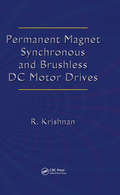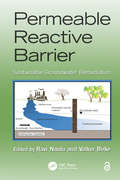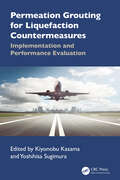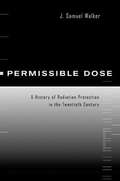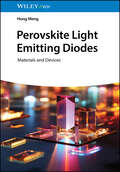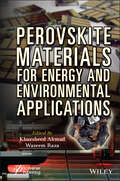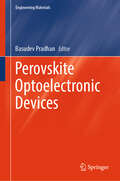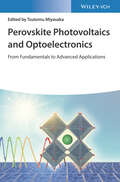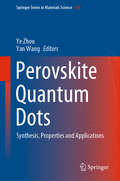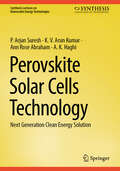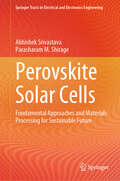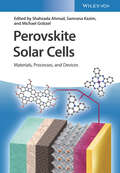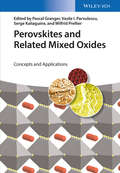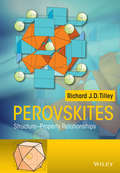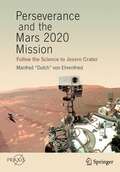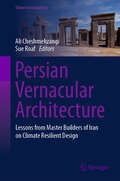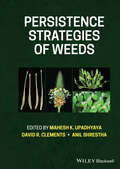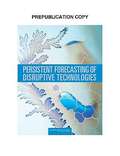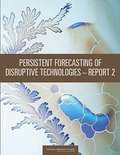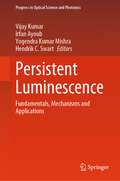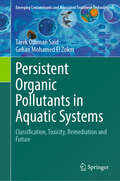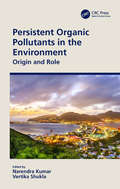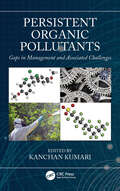- Table View
- List View
Permanent Magnet Synchronous and Brushless DC Motor Drives
by Ramu KrishnanDespite two decades of massive strides in research and development on control strategies and their subsequent implementation, most books on permanent magnet motor drives still focus primarily on motor design, providing only elementary coverage of control and converters. Addressing that gap with information that has largely been disseminated only in journals and at conferences, Permanent Magnet Synchronous and Brushless DC Motor Drives is a long-awaited comprehensive overview of power electronic converters for permanent magnet synchronous machines and control strategies for variable-speed operation. It introduces machines, power devices, inverters, and control, and addresses modeling, implementation, control strategies, and flux weakening operations, as well as parameter sensitivity, and rotor position sensorless control. Suitable for both industrial and academic audiences, this book also covers the simulation, low cost inverter topologies, and commutation torque ripple of PM brushless DC motor drives. Simulation of the motor drives system is illustrated with MATLAB® codes in the text. This book is divided into three parts—fundamentals of PM synchronous and brushless dc machines, power devices, inverters; PM synchronous motor drives, and brushless dc motor drives. With regard to the power electronics associated with these drive systems, the author: Explores use of the standard three-phase bridge inverter for driving the machine, power factor correction, and inverter control Introduces space vector modulation step by step and contrasts with PWM Details dead time effects in the inverter, and its compensation Discusses new power converter topologies being considered for low-cost drive systems in PM brushless DC motor drives This reference is dedicated exclusively to PM ac machines, with a timely emphasis on control and standard, and low-cost converter topologies. Widely used for teaching at the doctoral level and for industrial audiences both in the U.S. and abroad, it will be a welcome addition to any engineer’s library.
Permanent Record
by Edward SnowdenIn 2013, twenty-nine-year-old Edward Snowden shocked the world when he broke with the American intelligence establishment and revealed that the United States government was secretly pursuing the means to collect every single phone call, text message, and email. The result would be an unprecedented system of mass surveillance with the ability to pry into the private lives of every person on earth. Six years later, Snowden reveals for the very first time how he helped to build this system and why he was moved to expose it. Spanning the bucolic Beltway suburbs of his childhood and the clandestine CIA and NSA postings of his adulthood, Permanent Record is the extraordinary account of a bright young man who grew up online--a man who became a spy, a whistleblower, and, in exile, the Internet's conscience. Written with wit, grace, passion, and unflinching candor, Permanent Record is a crucial memoir of our digital age and destined to be a classic.
Permeable Reactive Barrier: Sustainable Groundwater Remediation (Advances in Trace Elements in the Environment #1)
by Ravi NaiduRemediation of groundwater is complex and often challenging. But the cost of pump and treat technology, coupled with the dismal results achieved, has paved the way for newer, better technologies to be developed. Among these techniques is permeable reactive barrier (PRB) technology, which allows groundwater to pass through a buried porous barrier that either captures the contaminants or breaks them down. And although this approach is gaining popularity, there are few references available on the subject. Until now. Permeable Reactive Barrier: Sustainable Groundwater Remediation brings together the information required to plan, design/model, and apply a successful, cost-effective, and sustainable PRB technology. With contributions from pioneers in this area, the book covers state-of-the-art information on PRB technology. It details design criteria, predictive modeling, and application to contaminants beyond petroleum hydrocarbons, including inorganics and radionuclides. The text also examines implementation stages such as the initial feasibility assessment, laboratory treatability studies (including column studies), estimation of PRB design parameters, and development of a long-term monitoring network for the performance evaluation of the barrier. It also outlines the predictive tools required for life cycle analysis and cost/performance assessment. A review of current PRB technology and its applications, this book includes case studies that exemplify the concepts discussed. It helps you determine when to recommend PRB, what information is needed from the site investigation to design it, and what regulatory validation is required.
Permeation Grouting for Liquefaction Countermeasures: Implementation and Performance Evaluation
by Yoshihisa Sugimura Kiyonobu KasamaAcademic and industry experts describe the use of chemical (permeation) grouting beneath an airport runway to improve ground resistance to liquefaction. They present the cost, environmental, and operational benefits; specifications; methodology; and practical results of this cutting-edge method. Because transportation infrastructure such as ports and airports are required to operate even in the event of a large earthquake, they must be resilient against liquefaction.Through contributions from experts in academia and industry, this book describes the discovery of construction defects at three airports in Japan and the subsequent project to repair and strengthen the ground using chemical grouting using environmentally friendly colloidal silica, the first time this technique was used in Japan. This book first describes chemical grouting and its benefits, its specifications, and field investigation results of its ground improvement performance. Next, it demonstrates a numerical and probabilistic method to model spatial variability in material properties of field data on improved ground. Finally, it explains a performance-based verification for airport runway availability in terms of bearing capacity and runway flatness after a large earthquake. Through its clear explanations, this book enables readers to implement chemical grouting and enjoy the cost, environmental, access, and operational benefits of this technique over traditional methodologies that would require temporary site closure and large-scale excavation. Because the concept and methodology described in this book are applicable to various geological, geotechnical, and seismological conditions depending on the location and structural and operational conditions depending on the infrastructure type, this book is a useful resource for geotechnical and other infrastructure engineers who must strengthen the ground without disrupting normal operations.
Permissible Dose: A History of Radiation Protection in the Twentieth Century
by J. Samuel WalkerA concise and readable guide to the historical development of radiation protection standards by federal government agencies from the Manhattan Project to the present.
Perovskite Light Emitting Diodes: Materials and Devices
by Hong MengPerovskite Light Emitting Diodes An introduction to revolutionary display technology Perovskite Light Emitting Diodes, commonly referred to as Pe-LEDs, leverage a perovskite nanocrystal core to engender a luminous and efficient diode, holding the potential to bring about a paradigm shift in the realm of display technology. In recent times, Pe-LEDs have garnered substantial industrial interest due to their intrinsic capability to exhibit a diverse array of colors with exceptional fidelity, their operation at low voltage thresholds, and their straightforward structural composition. The prospective implications for enabling cost-effective, heightened-performance flat-panel displays as well as flexible display solutions remain notably profound. Perovskite Light Emitting Diodes: Materials and Devices presents a comprehensive and insightful overview of these diodes and their multifaceted applications. Commencing with an incisive exploration of the historical trajectory of this technology, alongside a delineation of its foundational materials and intricate device architectures, this compendium provides a gateway into both contemporaneous state-of-the-art deployments and the vanguard of ongoing research endeavors directed towards charting future advancements. Perovskite Light Emitting Diodes readers will also find: Stability analysis for different Pe-LED devices, a key aspect of creating physical displays Authorship by an established expert in organic electronics Detailed discussion of perovskite preparation methods including ultrasonic, solvent heat, thermal injection, and many more Perovskite Light Emitting Diodes is ideal for materials scientists, electrical engineers, solid state chemists, solid state physicists, inorganic chemists, and any researchers or engineers working with display technology.
Perovskite Materials for Energy and Environmental Applications
by Waseem Raza Khursheed AhmadPEROVSKITE MATERIALS FOR ENERGY AND ENVIRONMENTAL APPLICATIONS The book provides a state-of-the-art summary and discussion about the recent progress in the development and engineering of perovskite solar cells materials along with the future directions it might take. Among all 3rd generation solar cells, perovskite solar cells have recently been attracting much attention and have also emerged as a hot research area of competing materials for silicon PV due to their easy fabrication, long charge-carrier lifetime, low binding energy, low defect density, and low cost.?? This book focuses primarily on the perovskite structures and utilizes them in modern technologies of photovoltaics and environmental applications. It will be unique in terms of the use of perovskite structures in solar cell applications. This book also discusses the type of perovskites, their synthetic approach, and environmental and solar cell applications. The book also covers how perovskite solar cells originated and the recent advances in perovskite solar cells.???? The reader will find in this book a lucid account that: Introduces the history of perovskite materials. Explores perovskite materials for energy conversion and environmental-related applications.?? Covers perovskite light absorber materials for the fabrication of high-performance perovskite solar cells.?? Describes the device architectures and physics of perovskite solar cells.?? Discusses the role of perovskite absorber, electron transport, and hole transport materials layers.?? Audience The book is essential reading for all those in the photovoltaic community, including materials scientists, surface physicists, surface chemists, solid-state physicists, solid-state chemists, and electrical engineers.??
Perovskite Optoelectronic Devices (Engineering Materials)
by Basudev PradhanThis book delves into the practical applications of perovskite materials in optoelectronics, covering solar cells, light-emitting diodes, photodetectors, neuromorphic devices, lasers, and X-ray detectors in various forms including bulk, two-dimensional (2D), and zero-dimensional (0D). It addresses the pressing need for scalable fabrication processes, performance optimization, and stability concerns associated with perovskite-based devices. With a detailed examination of fundamental properties and challenges, this book serves as a comprehensive guide for scientists, technologists, and engineers involved in developing and optimizing perovskite-based optoelectronic devices for commercialization. Furthermore, it fills a significant gap in the literature by providing in-depth coverage of perovskite solar cells and other emerging optoelectronic technologies, making it an essential resource for researchers and practitioners in materials and device physics.
Perovskite Oxide for Solid Oxide Fuel Cells
by Tatsumi IshiharaThe continuing development of fuel cells offers promising technologies for the conversion of chemical energy from hydrocarbon fuels into electricity without forming air pollutants. Perovskite Oxides for Solid Oxide Fuel Cells provides insight into the materials aspects of one of the most promising fuel cell types available. Solid Oxide Fuel Cells (SOFCs) have significant advantages over other fuel cell types, such as high efficiency, flexibility in fuel, high reliability, simple balance of plant (BOP) and a long history. Because of these advantages, SOFC technology is attracting a great deal of attention for use in power generation and for its potential in heat generation. Perovskite oxides are widely used for different SOFC components. Detailed description of various aspects of perovskite oxides are presented in this book. Each chapter in the book is written by leading international researchers and covers topics including: General Introduction of SOFC; Perovskite fast oxide ion conductors; High temperature perovskite proton conductors; Perovskite electrode catalyst and catalysis; SOFC stack development using perovskite oxide; The effects of decreasing SOFC operating temperatures to increase reliability, durability and stability. Perovskite Oxides for Solid Oxide Fuel Cells provides comprehensive and up-to-date information on the materials, properties, and performance for SOFCs and is appropriate for researchers and engineers in the field.
Perovskite Photovoltaics and Optoelectronics: From Fundamentals to Advanced Applications
by Tsutomu MiyasakaPerovskite Photovoltaics and Optoelectronics Discover a one-of-a-kind treatment of perovskite photovoltaics In less than a decade, the photovoltaics of organic-inorganic halide perovskite materials has surpassed the efficiency of semiconductor compounds like CdTe and CIGS in solar cells. In Perovskite Photovoltaics and Optoelectronics: From Fundamentals to Advanced Applications, distinguished engineer Dr. Tsutomu Miyasaka delivers a comprehensive exploration of foundational and advanced topics regarding halide perovskites. It summarizes the latest information and discussion in the field, from fundamental theory and materials to critical device applications. With contributions by top scientists working in the perovskite community, the accomplished editor has compiled a resource of central importance for researchers working on perovskite related materials and devices. This edited volume includes coverage of new materials and their commercial and market potential in areas like perovskite solar cells, perovskite light-emitting diodes (LEDs), and perovskite-based photodetectors. It also includes: A thorough introduction to halide perovskite materials, their synthesis, and dimension control Comprehensive explorations of the photovoltaics of halide perovskites and their historical background Practical discussions of solid-state photophysics and carrier transfer mechanisms in halide perovskite semiconductors In-depth examinations of multi-cation anion-based high efficiency perovskite solar cells Perfect for materials scientists, crystallization physicists, surface chemists, and solid-state physicists, Perovskite Photovoltaics and Optoelectronics: From Fundamentals to Advanced Applications is also an indispensable resource for solid state chemists and device/electronics engineers.
Perovskite Quantum Dots: Synthesis, Properties and Applications (Springer Series in Materials Science #303)
by Yan Wang Ye ZhouThis book addresses perovskite quantum dots, discussing their unique properties, synthesis, and applications in nanoscale optoelectronic and photonic devices, as well as the challenges and possible solutions in the context of device design and the prospects for commercial applications. It particularly focuses on the luminescent properties, which differ from those of the corresponding quantum dots materials, such as multicolor emission, fluorescence narrowing, and tunable and switchable emissions from doped nanostructures. The book first describes the characterization and fabrication of perovskite quantum dots. It also provides detailed methods for analyzing the electrical and optical properties, and demonstrates promising applications of perovskite quantum dots. Furthermore, it presents a series of optoelectronic and photonic devices based on functional perovskite quantum dots, and explains the incorporation of perovskite quantum dots in semiconductor devices and their effect of the performance. It also explores the challenges related to optoelectronic devices, as well as possible strategies to promote their commercialization. As such, this book is a valuable resource for graduate students and researchers in the field of solid-state materials and electronics wanting to gain a better understanding of the characteristics of quantum dots, and the fundamental optoelectronic properties and operation mechanisms of the latest perovskite quantum dot-based devices.
Perovskite Solar Cells Technology: Next Generation Clean Energy Solution (Synthesis Lectures on Renewable Energy Technologies)
by A. K. Haghi Ann Rose Abraham K. V. Kumar P. Arjun SureshSolar energy is considered one of the most important forms of renewable energy. Silicon solar cells are commonly used in the photovoltaic industry, but their higher production costs and complicated fabrication processes make them less affordable. Various other technologies, such as perovskite solar cells and dye-sensitized solar cells, are also emerging. Among these, perovskite solar cells are promising type of solar cells, offering comparable efficiency to that of silicon solar cells, at significantly lower costs. However, one of the drawbacks of perovskite solar cells is their relatively short lifespan, which limits their applications. Researchers are actively working to improve both the lifetime and efficiency of perovskite solar cells. This book begins by covering the basics of solar energy and the principles and different types of solar cells. The focus is then put on perovskite solar cells, how they work, their advantages and challenges, and what sets them apart from other solar cells. Device fabrication techniques and recent advancements in the field are discusses next, finishing up with a look into the future of solar cell technology.
Perovskite Solar Cells: Fundamental Approaches and Materials Processing for Sustainable Future (Springer Tracts in Electrical and Electronics Engineering)
by Abhishek Srivastava Parasharam M. ShirageThis book excavates into both the foundational principles and the latest advancements in perovskite solar cell research. It presents ground-breaking results about the diverse applications of perovskite solar cells, offering readers a comprehensive overview of the field's current state. By combining fundamental knowledge with cutting-edge methods, this book equips researchers, students, and professionals with valuable insights, fostering innovation and progress in the realm of perovskite solar cell technology. This volume captivates readers with a diverse array of intriguing topics. The book provides valuable insights into tackling challenges and discovering solutions, from the in-depth exploration of various electrical modeling techniques to the revelation of advanced perovskite fabrication methods. Additionally, readers will be engrossed by the exploration of efficiency improvements and the unveiling of novel applications in the realm of renewable energy. This comprehensive coverage ensures that the book appeals to researchers, engineers, and enthusiasts, inspiring them to delve deeper into the world of perovskite solar cells and contribute to sustainable energy solutions. The book also features an array of detailed illustrations and tables, facilitating a comprehensive comparison of different perovskite types. Through a didactic approach, complex concepts are presented in a reader-friendly manner, enabling researchers and enthusiasts alike to grasp cutting-edge methods, results, and applications in the field of perovskite solar cells. This book serves as a valuable resource, empowering readers to contribute to the advancement of clean energy solutions with a deeper understanding of next-generation technologies. This book offers readers a transformative opportunity to develop a comprehensive understanding of perovskite solar cells. Through its insightful exploration of fundamental principles, cutting-edge methods, and ground-breaking applications, the book equips readers with the knowledge and expertise needed to actively participate in developing next-generation clean energy solutions. This invaluable resource empowers researchers, engineers, and students to embrace the potential of perovskite solar cells, driving innovation and progress in the pursuit of a sustainable and environmentally friendly future.
Perovskite Solar Cells: Materials, Processes, and Devices
by Shahzada AhmadPresents a thorough overview of perovskite research, written by leaders in the field of photovoltaics The use of perovskite-structured materials to produce high-efficiency solar cells is a subject of growing interest for academic researchers and industry professionals alike. Due to their excellent light absorption, longevity, and charge-carrier properties, perovskite solar cells show great promise as a low-cost, industry-scalable alternative to conventional photovoltaic cells. Perovskite Solar Cells: Materials, Processes, and Devices provides an up-to-date overview of the current state of perovskite solar cell research. Addressing the key areas in the rapidly growing field, this comprehensive volume covers novel materials, advanced theory, modelling and simulation, device physics, new processes, and the critical issue of solar cell stability. Contributions by an international panel of researchers highlight both the opportunities and challenges related to perovskite solar cells while offering detailed insights on topics such as the photon recycling processes, interfacial properties, and charge transfer principles of perovskite-based devices. Examines new compositions, hole and electron transport materials, lead-free materials, and 2D and 3D materials Covers interface modelling techniques, methods for modelling in two and three dimensions, and developments beyond Shockley-Queisser Theory Discusses new fabrication processes such as slot-die coating, roll processing, and vacuum sublimation Describes the device physics of perovskite solar cells, including recombination kinetics and optical absorption Explores innovative approaches to increase the light conversion efficiency of photovoltaic cells Perovskite Solar Cells: Materials, Processes, and Devices is essential reading for all those in the photovoltaic community, including materials scientists, surface physicists, surface chemists, solid state physicists, solid state chemists, and electrical engineers.
Perovskites and Related Mixed Oxides
by Vasile I. Parvulescu Pascal Granger Wilfrid Prellier Serge KaliaguineThis comprehensive handbook and ready reference details all the main achievements in the field of perovskite-based and related mixed-oxide materials. The authors discuss, in an unbiased manner, the potentials as well as the challenges related to their use, thus offering new perspectives for research and development on both an academic and industrial level. The first volume begins by summarizing the different synthesis routes from molten salts at high temperatures to colloidal crystal template methods, before going on to focus on the physical properties of the resulting materials and their related applications in the fields of electronics, energy harvesting, and storage as well as electromechanics and superconductivity. The second volume is dedicated to the catalytic applications of perovskites and related mixed oxides, including, but not limited to total oxidation of hydrocarbons, dry reforming of methane and denitrogenation. The concluding section deals with the development of chemical reactors and novel perovskite-based applications, such as fuel cells and high-performance ceramic membranes. Throughout, the contributions clearly point out the intimate links between structure, properties and applications of these materials, making this an invaluable tool for materials scientists and for catalytic and physical chemists.
Perovskites: Structure-Property Relationships
by Richard J. TilleyUniquely describes both the crystallography and properties of perovskite related materials. Practical applications in solar cells, microelectronics and telecommunications Interdisciplinary topic drawing on materials science, chemistry, physics, and geology Contains problems and answers to enhance knowledge retention
Perseverance and the Mars 2020 Mission: Follow the Science to Jezero Crater (Springer Praxis Books)
by Manfred "Dutch" von EhrenfriedThis is the comprehensive story of NASA’s pioneering Mars 2020 mission, which at this moment continues to break ground on the surface of the Red Planet.The book takes readers through every stage of the Mars mission, describing its major goals and objectives, the cutting-edge technology and instrumentation onboard the Perseverance rover and other spacecraft components, and the members of the scientific team who steered the mission along the way. Mars 2020 is the first to actually take samples of the Red Planet and prepare them for subsequent return to Earth. The chapters therefore delve into how and why Jezero Crater was selected as the optimal landing and sample collecting site to meet the mission objectives. Featuring dozens of high-resolution images of the mission, this book gives readers a deeper understanding of the technology underlying Mars 2020 and why its work is so important for planetary science and space exploration.
Persian Vernacular Architecture: Lessons from Master Builders of Iran on Climate Resilient Design (Urban Sustainability)
by Ali Cheshmehzangi Sue RoafThis timely book aims to address a significant challenge in contemporary design and architecture, i.e., “to learn from the vernacular”. Vernacular architecture refers to traditional and indigenous building styles that have evolved in response to local climate, materials, and cultural practices. These styles often embody 'extreme' design principles, as they support life without relying on modern mechanical systems for heating and cooling. The core premise of the book is that these time-tested design solutions offer valuable lessons for real sustainable and climate-resilient architecture today. We strongly urge a return to the vernacular as a source of inspiration and knowledge. Hence, a genuine dedication to dedicated Ostads or master builders of Iran, who have contributed extensively to making and co-creating climate-resilient architecture and climate-sensitive design. This is more than just a box-ticking sustainability exercise and delves more deeply into the building performance and its impact on our everyday life, our health and wellbeing, and us as human beings. The book posits that contemporary architects and designers can learn valuable lessons by studying the adaptive strategies and sustainable practices embedded in the traditional vernacular architecture of Iran. These lessons are crucial for addressing modern challenges such as climate change, resource scarcity, and the need for energy-efficient buildings. By revisiting and analysing vernacular architecture, the book aims to bridge the gap between traditional knowledge and contemporary design practices. It provides a comprehensive exploration of how vernacular principles can be integrated into modern architectural education and practice. The goal is not only to preserve traditional wisdom but also to innovate upon it, creating buildings that are both culturally relevant and environmentally sustainable. The contributing case study chapters of the book include an excellent range of practical recommendations for architects, researchers, and policymakers. By fostering a deeper understanding of vernacular architecture, the book seeks to inspire a new generation of architects to create buildings that are harmonious with their environment and resilient to future challenges. Through this approach, we believe lessons from vernacular buildings ought to offer the promise of reintegrating real Resilience into the design of the next generation of buildings.
Persistence Strategies of Weeds
by Mahesh K. Upadhyaya David R. Clements Anil ShresthaAn invaluable source of up-to-date information on all major aspects of weed persistence Weeds negatively impact crop yields, the quality of agricultural produce, the health of livestock and ecosystems, and various aspects of human life. Despite significant expenditures of time, money, and resources by agricultural producers, land managers, and the general public, weeds persist. Developing new methods for protecting crops and the environment requires a thorough understanding of the persistence mechanisms of weeds. In Persistence Strategies of Weeds, an international team of expert authors provide detailed information on weed seed biology, identify the vulnerabilities of different weeds, and address the underlying issues behind the problem of weed persistence despite various management methods including herbicides. Presenting a comprehensive approach to the subject, the authors describe what is already understood about weed persistence and what yet needs to be determined. Topics include the role of seed production, dissemination, seed banks, the physiology and genetics of seed dormancy, the influence of agronomic practices, seed longevity, vegetative propagation, allelopathy, predation, soil microbes, weed evolution, and more. This authoritative volume: Examines the genetic flexibility of weeds to adapt to changes in agricultural practices and management strategies Discusses the release of allelochemicals by certain weeds that inhibit the growth of competing plant species Explores the influence of climate change on weed persistence and how the efficacy of herbicides will be affected Emphasizes the importance of sustainable crop production and reducing dependence on synthetic herbicides Provides extensive coverage of the roles of genetic, environmental, and morphological factors in the regulation of weed seed dormancy Includes an overview of persistence strategies of weeds, detailed case studies, and numerous illustrative examples Persistence Strategies of Weeds is an ideal textbook for all upper-level undergraduate and graduate students of weed and pest biology, agroecology, or organic agriculture, and a must-have reference for weed scientists and weed management professionals.
Persistent Forecasting of Disruptive Technologies
by National Research Council of the National AcademiesTechnological innovations are key causal agents of surprise and disruption. In the recent past, the United States military has encountered unexpected challenges in the battlefield due in part to the adversary's incorporation of technologies not traditionally associated with weaponry. Recognizing the need to broaden the scope of current technology forecasting efforts, the Office of the Director, Defense Research and Engineering (DDR&E) and the Defense Intelligence Agency (DIA) tasked the Committee for Forecasting Future Disruptive Technologies with providing guidance and insight on how to build a persistent forecasting system to predict, analyze, and reduce the impact of the most dramatically disruptive technologies. The first of two reports, this volume analyzes existing forecasting methods and processes. It then outlines the necessary characteristics of a comprehensive forecasting system that integrates data from diverse sources to identify potentially game-changing technological innovations and facilitates informed decision making by policymakers. The committee's goal was to help the reader understand current forecasting methodologies, the nature of disruptive technologies and the characteristics of a persistent forecasting system for disruptive technology. Persistent Forecasting of Disruptive Technologies is a useful text for the Department of Defense, Homeland Security, the Intelligence community and other defense agencies across the nation.
Persistent Forecasting of Disruptive Technologies - Report 2
by National Research Council of the National AcademiesThe term "disruptive technology" describes a technology that results in a sudden change affecting already established technologies or markets. Disruptive technologies cause one or more discontinuities in the normal evolutionary life cycle of technology. This may lead to an unexpected destabilization of an older technology order and an opportunity for new competitors to displace incumbents. Frequently cited examples include digital photography and desktop publishing. The first report of the series, Persistent Forecasting of Disruptive Technologies, discussed how technology forecasts were historically made, assessed various existing forecasting systems, and identified desirable attributes of a next-generation persistent long-term forecasting system for disruptive technologies. This second book attempts to sketch out high-level forecasting system designs. In addition, the book provides further evaluation of the system attributes defined in the first report, and evidence of the feasibility of creating a system with those attributes. Together, the reports are intended to help the Department of Defense and the intelligence community identify and develop a forecasting system that will assist in detecting and tracking global technology trends, producing persistent long-term forecasts of disruptive technologies, and characterizing their potential impact on future U.S. warfighting and homeland defense capabilities.
Persistent Luminescence: Fundamentals, Mechanisms and Applications (Progress in Optical Science and Photonics #30)
by Vijay Kumar Hendrik C. Swart Yogendra Kumar Mishra Irfan AyoubThis book presents the fundamental and applied properties of different phosphor materials that exhibit the phenomenon of persistent luminescence (PerLum). PerLum offers a solution for the limitations of existing fluorescent probes, with new lanthanide-based materials for in vivo bio-imaging and demonstrates the practical applications of these materials. The book offers a basic understanding of PerLum, different mechanisms, models, related spectroscopic techniques, and a few applications essential for anyone interested in learning about PerLum materials. This is partly due to the fact that the property of long-lasting luminescence is closely associated with other properties and functionalities, which besides being essential for many technological applications, such as bioimaging and biosensing, involve in-depth physics and chemistry. Although the concept of luminescence has been explored for many decades, the different types of luminescence have always led to versatile breakthroughs in different fields of science and technology. Among the same is one more well-established phenomenon known as "PerLum," which is characterized by the maintenance of luminescence for periods ranging from minutes to hours in the absence of an external excitation source. Because of their remarkable properties, an enormous number of PerLum materials have been developed and are now widely used in a variety of fields, particularly bioimaging, biosensing, therapeutics, etc.
Persistent Organic Pollutants in Aquatic Systems: Classification, Toxicity, Remediation and Future (Emerging Contaminants and Associated Treatment Technologies)
by Gehan Mohamed El Zokm Tarek Othman SaidThis book addressed an in-depth comprehension of the classifications and characterizations of POPs, which have become global issues due to bioaccumulation, persistency, and toxicity. It represents the milestones of the development of pesticide application, industry, and management. Banned SC-POPs have special investigations. It discusses air-sea exchange, ocean currents, phase distribution, speciation, adsorption, desorption, and degradation as the key processes that control POP's fate. The book explores several aspects of POP chemistry that have a direct influence on their biochemical and toxicological consequences. The book illustrates the dynamic equilibriums influencing the proportion of a POP's gaseous, liquid, and solid phases. The book discussed POP migration by referring to the grasshopper effect. It also explores the impacts of climate change on emissions and the fate of POPs through a global-scale multimedia fate model. Additionally, it displays the impact of potential global change scenarios on POP bioaccumulation patterns. The book is directed at giving a deep discussion of the method's QA/QC process for POP determination and has verified the accuracy and precision of the procedures. As a distinctive point, it discusses many aspects concerning the toxicity of POPs. It reports mechanisms describing the toxicity of POPs on immune systems, carcinogenesis, endocrine, neural, and reproductive systems. The book keeps an eye on a model describing the global distribution and toxicity of PAHs. Among the exclusive points in the book is the evaluation of the recent ecological status in Egypt relative to POPs through a time-scale overview and recent case studies. It provides thematic literature related to DDC research in Africa through the WoS and Scopus databases from 1949 to 2021. The book emphasizes models for predicting the annual contribution rate of POPs as a way to raise public awareness about POPs. The greatest challenge for the book is how to motivate the audience to be aware of these hazardous materials in marine ecosystems. Moreover, this book will be of great interest to academics, professionals, practitioners, post-graduate students, and undergraduates because it gives a clear overview of POPs in the marine environment. It also provides decision-makers with a realistic perspective of the environmental file, allowing them to address environmental issues and directing stockholders to safer locations for environmental activity. From a future perspective, the regulation of pervasive POPs, with special reference to recently evaluated harmful substances (PFASs), has faced significant challenges in the wake of pressure from regulators.
Persistent Organic Pollutants in the Environment: Origin and Role
by Narendra KumarPersistent Organic Pollutants (POPs) are toxic, degradation resistant, bio accumulative, and display wide spatial distribution which has been linked to mutagenic, reproductive and immunological disorders. In Stockholm Persistent Organic Pollutants (POPs) are toxic, degradation resistant, bio-accumulative, and display wide spatial distribution, which has been linked to mutagenic, reproductive, and immunological disorders. At the Stockholm Convention, a global treaty was signed to minimize and ultimately eliminate the release of POPs into the environment. The present compilation regarding POPs focusses on the sources, atmospheric behavior, terrestrial and aquatic food chain transfer, human exposure, and fate aspects of this important class of chemicals, including topical issues like temporal trends in contamination. Furthermore, the chemical characteristics of individual POPs are also addressed. Features: Provides better understanding of Persistent Organic Pollutants (POPs) and how they affect humans and ecosystems. Includes genesis, categories, environmental fate and behavior, and associated hazards. Reviews analytical techniques involved in detection, human exposure and management. Discusses environmental dynamics of POPs. Focuses on the comprehensive account of PCDD/Fs, PCBs, PAH and other organochlorine POPs, such as DDT, lindane, and dieldrin. This book is aimed at researchers, professionals and graduate students in Life Science, Occupational Health and Safety, Chemical Engineering and Environmental Engineering.
Persistent Organic Pollutants: Gaps in Management and Associated Challenges
by Kanchan KumariPersistent Organic Pollutants (POPs) are chemicals that resist environmental degradation and cause deleterious effects on the environment and human wellbeing. Once released into the environment they can travel long distances and persist for longer duration. This book highlights the complex area of POPs in simple language and deals with the fundamentals of the chemicals, their sources, and impacts on human health. The book also unfolds several other aspects like new and advanced analytical detection methods, gaps in management, effectiveness of the Stockholm convention, and the role of the global monitoring plan on POPs for crucial and holistic understanding about POPs. It also investigates how to minimize the impact of POPs and the major gaps and challenges in sound management of POPs. With its comprehensive approach, this book is an indispensable source of knowledge for those studying and working to mitigate the effect of POPs in the environment.
